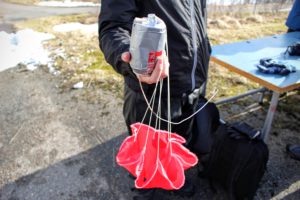Satellites normally do not return to Earth in a parachute. At the end of their useful life, a satellite will be put in a different orbit. For satellites orbiting at a low altitude this could mean they will burn up in the atmosphere. Satellites further away will end up in a much more distant parking orbit and will circle our planet forever.
Sometimes however the spacecraft has to return to earth with samples or astronauts. One of the solutions is then to descend in a parachute.
When the CanSat is deployed it must have a device to slow it down, otherwise it will crash into the surface. The parachute also helps ensure that the CanSat stays in an upright position. This is particularly important because it helps to maintain proper antenna orientation, which maximises the chances of receiving telemetry. These pages will guide you through the different steps needed to design and built your parachute.
Required Descent Parameters
The values listed below are preliminary and can change in advance of a CanSat competition and launch campaign. However, they can be used as a temporary guideline. Uncertainties in the Launch Campaign could lead to a different value for the eventual descent velocities.
| Minimal descent Velocity: | 8 m/s |
| Maximal descent Velocity: | 11 m/s |
| Allowed mass: | 300 – 350 g |
| Drag coefficients: | |
| Semi Spherical: | 1.5 |
| Cross Shaped: | 0.8 |
| Parapent: | depends on the design (can be determined by tests) |
| Flat, hexagon: | 0.8 |
Parachute Production
When the design of the parachute is finished you can start the production process. There are however a few important issues to keep in mind during this process. Deployment of the parachute will be relatively violent, so the fabric and fibres you use need to be strong. Most often you can get nylon cord and ripstop fabric at a kite shop. These materials are ideally suited for the parachute.
When cutting the fabric keep in mind that some of the fabrics need to be cast double in order to sew it.
More handy tips on parachute production can be found here.
When the parachute is done, the best way to check if it works is to actually test it.


